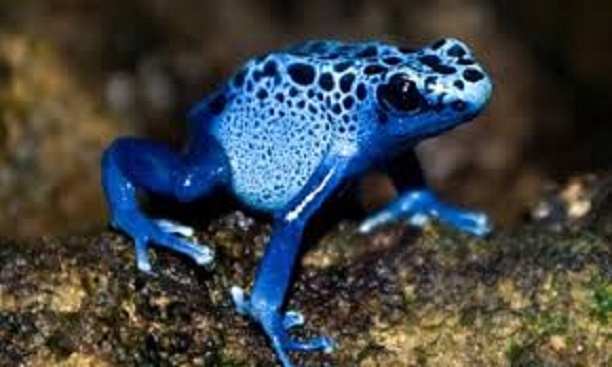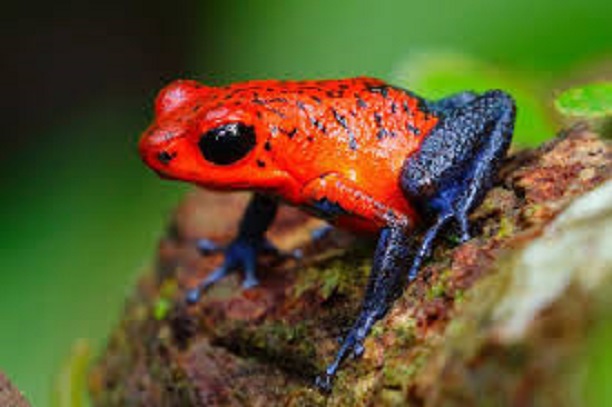Cool Frogs are Cool


With a range of bright colors—yellows, oranges, reds, greens, blues—poison dart frogs aren't just big show-offs either. Those colorful designs tell potential predators, "I'm toxic. Don't eat me." For example, the golden poison dart frog has enough poison to kill 20,000 mice. Scientists think that poison dart frogs get their toxicity from some of the insects they eat.
How do poison dart frogs capture their prey? Slurp! With a long, sticky tongue that darts out and zaps the unsuspecting bug! The frogs eat many kinds of small insects, including fruit flies, ants, termites, young crickets, and tiny beetles, which are the ones scientists think may be responsible for the frogs' toxicity.
Dendrobatids include some of the most toxic animals on Earth. The two-inch-long golden poison frog has enough poison to kill 10 grown men. Indigenous Emberá people of Colombia have used its powerful poison for centuries to tip their blowgun darts when hunting, hence the genus' common name.
Natural habitats include subtropical and tropical, moist, lowland forests, subtropical or tropical high-altitude shrubland, subtropical or tropical, moist, montanes and rivers, freshwater marshes, intermittent freshwater marshes, lakes and swamps. Other species can be found in seasonally wet or flooded lowland grassland, arable land, pastureland, rural gardens, plantations, moist savanna and heavily degraded former forest. Premontane forests and rocky areas have also been known to hold frogs. Dendrobatids tend to live on or close to the ground, but also in trees as much as 10 m (33 ft) from the ground.
Many species of poison dart frogs are dedicated parents. Many poison dart frogs in the genera Oophaga and Ranitomeya carry their newly hatched tadpoles into the canopy; the tadpoles stick to the mucus on the backs of their parents. Once in the upper reaches of the rainforest trees, the parents deposit their young in the pools of water that accumulate in epiphytic plants, such as bromeliads. The tadpoles feed on invertebrates in their nursery, and their mother will even supplement their diet by depositing eggs into the water. Other poison frogs lay their eggs on the forest floor, hidden beneath the leaf litter. Poison frogs fertilize their eggs externally; the female lays a cluster of eggs and a male fertilizes them afterward, in the same manner as most fish. Poison frogs can often be observed clutching each other, similar to the manner most frogs copulate. However, these demonstrations are actually territorial wrestling matches. Both males and females frequently engage in disputes over territory. A male will fight for the most prominent roosts from which to broadcast his mating call; females fight over desirable nests, and even invade the nests of other females to devour competitor's eggs.
Chemicals extracted from the skin of Epipedobates tricolor may be shown to have medicinal value. Scientists use this poison to make a painkiller.[29] One such chemical is a painkiller 200 times as potent as morphine, called epibatidine; however, the therapeutic dose is very close to the fatal dose.[30] A derivative ABT-594 developed by Abbott Laboratories, called Tebanicline got as far as Phase II trials in humans,[31] but was dropped from further development due to unacceptable incidence of gastrointestinal side effects.[32] Secretions from dendrobatids are also showing promise as muscle relaxants, heart stimulants and appetite suppressants.[33] The most poisonous of these frogs, the golden poison frog (Phyllobates terribilis), has enough toxin on average to kill ten to twenty men or about ten thousand mice.[34] Most other dendrobatids, while colorful and toxic enough to discourage predation, pose far less risk to humans or other large animals.
Skin toxicity evolved alongside bright coloration,[35] perhaps preceding it.[3] Toxicity may have relied on a shift in diet to alkaloid-rich arthropods,[24] which likely occurred at least four times among the dendrobatids.[24] Conspicuous coloration in these frogs is further associated with diet specialization, body mass, aerobic capacity, and chemical defense.[9] Either aposematism and aerobic capacity preceded greater resource gathering, making it easier for frogs to go out and gather the ants and mites required for diet specialization, contrary to classical aposematic theory, which assumes that toxicity from diet arises before signaling. Alternatively, diet specialization preceded higher aerobic capacity, and aposematism evolved to allow dendrobatids to gather resources without predation.
 Cool Frogs
Cool Frogs